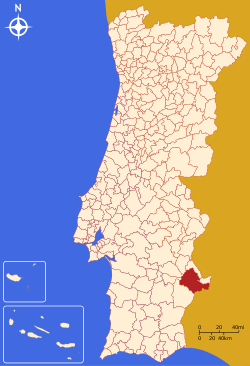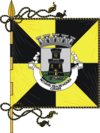Moura Municipality
From Wikipedia, the free encyclopedia
| Moura | |||
|---|---|---|---|
| Municipality | |||
| |||
 | |||
| Coordinates: 38°08′N 7°27′W / 38.133°N 7.450°WCoordinates: 38°08′N 7°27′W / 38.133°N 7.450°W | |||
| Country |
| ||
| Region | Alentejo | ||
| Subregion | Baixo Alentejo | ||
| District/A.R. | Beja | ||
| Government | |||
| • Mayor | José Pós de Mina (CDU) | ||
| Area | |||
| • Total | 958.4 km2 (370.0 sq mi) | ||
| Population | |||
| • Total | 16,411 | ||
| • Density | 17/km2 (40/sq mi) | ||
| Parishes (no.) | 8 | ||
| Municipal holiday |
Saint John June 24 | ||
| Website | http://www.cm-moura.pt | ||
Moura (Portuguese pronunciation: [ˈmowɾɐ]) is a municipality in Portugal with a total area of 958.4 km² and a total population of 16,411 inhabitants. The city itself has a population of 8,459.[1]
The municipality is composed of 8 parishes, and is located in the District of Beja.
The current Mayor is José Pós de Mina, elected by the Unitarian Democratic Coalition.
The municipal holiday is 24 June.
It is home to Moura Photovoltaic Power Station, one of Europe's largest solar-power facilities.
It is also home to one of the best historical restaurants in the region of Alentejo (being featured in various international touristic guides), The Fronteiro-Mor.
Parishes

Moura houses with typical Alentejo landscape in the background
- Amareleja
- Santo Agostinho
- São João Baptista
- Póvoa de São Miguel
- Safara
- Santo Aleixo da Restauração
- Santo Amador
- Sobral da Adiça
See also
- Moura IPR
References
- ↑ UMA POPULAÇÃO QUE SE URBANIZA, Uma avaliação recente - Cidades, 2004 Nuno Pires Soares, Instituto Geográfico Português (Geographic Institute of Portugal)
External links
| |||||
This article is issued from Wikipedia. The text is available under the Creative Commons Attribution/Share Alike; additional terms may apply for the media files.

